| Item |
|
Description |
| Import parameters
|
Using
the Open dialog, you can load the parameters that are stored in a .xml file. |
| Export parameters
|
The parameters that you configure in this dialog can be saved
to a .xmlfile using the Save As dialog. |
| Layer mapping
|
- Set the association between layers in the
design and the DXF layers.
- To add a combination of layers, select
, , or on the assist menu.
- If is selected, all layers displayed in the
Select Layer dialog
are added.
- If is selected, layers are added for which Visible
layer is set to ON
in Layer View on the
Layer Settings panel.
- Then, enter DXF
layer name corresponding to the specified Layer name.
- To not change the orientation of the layer, set Mirror
to None.
Note
Output from one layer to multiple DXF layers
is not possible.
|
| |
Target hole
|
Allows you to specify whether a hole layer is exported to a single layer, or whether individual layers are exported for each layer that the hole passes through. It is recommended to select the required option before adding layers to the Layer mapping table.- Match specified layers: If selected, then the From-To values are not changed for the layers in the Select Layer dialog, and a selected hole layer is exported as a single layer. For example, the hole layer 'Hole (1-4)' is exported to the layer, 'Hole (1-4)'.
- Include specified layers: If selected, then you can select a layer in the Select Layer dialog for each From-To value. For example, the hole layer 'Hole (1-4)' is exported to the following layers:
'Hole (1-2)'
'Hole (2-3)'
'Hole (3-4)'.
Note
If you change this setting after adding layers to the table, then any existing hole layers are removed from the table. They are not readded if you restore the setting. |
| |
Layer to convert
|
Allows you to specify how layers are converted when exported
to a DXF file. |
| |
|
| Item |
|
Description |
| DXF layer name
|
|
Define the layer name in the DXF file. Besides specifying
layers on the Layer mapping
page, you can create DXF layers using the following functions:
- Output reference name.
- Output negative figures for a conductor
layer. These are exported to a new DXF layer, as specified
in the Layer name
column, using the following rule: "%Layer name%_nega".
- The following types of figure are
exported:
- Clearance land.
- Thermal land.
- Meshes in mesh planes.
|
| Layer name
|
|
In the displayed Select Layer dialog, select the layer name in the design. This dialog is launched by pointing the cursor in this column, and clicking the displayed  button. button. |
| Color
|
|
Allows you to specify the color of each exported layer
by specifying a color number or color name, or by selecting
a color in the
Select DXF Color dialog. If you do not specify a value, the DXF color number
is used that is closest to the RGB value of the layer
color.
- To specify a color number, enter
an integer between 1 and 255 and press Return
on the keyboard. The specified number is displayed
in the cell, and the cell is filled using the corresponding
color.
- The specify a color name, enter
it in the cell, and press Return
on the keyboard. The specified name is displayed,
and the cell is filled using the corresponding color.
You can enter one of the following values. These are
displayed in the first row of the Select DXF Color dialog, as shown below.

- red
- yellow
- green
- cyan
- blue
- magenta
- white
- To select a color from the palette,
point the cursor at the relevant cell in the Color column, and then
click the displayed "..."
button. The Select DXF Color
dialog is displayed. Select a color in the dialog
and click OK. The color
name or color number is displayed, and the cell is
filled using the corresponding color.
- The first row of the palette displays
the following colors. The corresponding color names
and color numbers are also shown below.

- red
- yellow
- green
- cyan
- blue
- magenta
- white
- 8
- 9
- The last row of the palette displays
the shades of gray, as shown below.

Note
If the exported DXF file is subsequently
imported into eCADSTAR, the colors that you specify are
not used. This is because these settings are overruled
by the layer color settings in eCADSTAR. However,
they may be used by other drawing packages. |
| Mirror
|
None
|
The layer that is specified in the Layer
name column is exported without being changed.
For example:
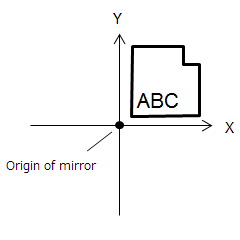 |
| X
|
The layer is mirrored in the X direction when exported.
For example:
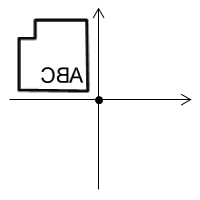 |
| Y
|
The layer is mirrored in the Y direction when exported.
For example:
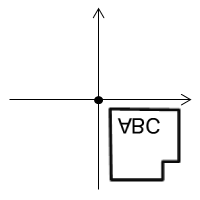 |
| Only char. in X
|
Only characters are mirrored in the X direction when
the layer is exported. For example:
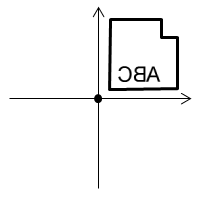 |
| Only char. in Y
|
Only characters are mirrored in the Y direction when
the layer is exported. For example:
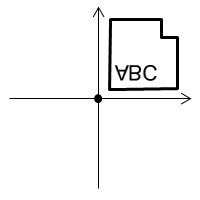 |
| Exclude char. in X
|
All objects except characters are mirrored in the X
direction when the layer is exported. For example:
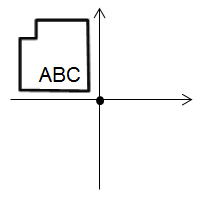 |
| Exclude char. in Y
|
All objects except characters are mirrored in the Y
direction when the layer is exported. For example:
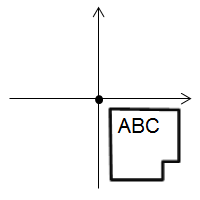
|
|
| |
|
The following items, specific to the Layer
to convert box, are available by right-clicking in the
Layer to convert box.
| Item | Description |
|---|
| Adds rows for all layers to the Layer
to convert box. | | Adds rows for all visible layers to the Layer
to convert box. | | Displays the Select
Layer dialog. This dialog allows you to select the
layers to be added to the Layer to
convert box. You can select board layers, conductor
layers, non-conductor layers and user-defined layers. | | Deletes all selected rows from the Layer
to convert box. |
|
| |

|
Moves the row that is selected in the Layer
to convert box to the Layer
not to convert box. Select
multiple rows using the CTRL or
Shift keys, or by dragging the cursor. |
| |

|
Moves the row that is selected in the Layer
not to convert box to the Layer to convert box. Select multiple
rows using the CTRL or Shift
keys, or by dragging the cursor. |
| |
Layer not to convert
|
The Layer not to convert box allows you to save the settings in
the Layer to convert box.
- The values in the Layer
not to convert box are
read-only.
- Only the settings specified in the Layer to convert box are referenced
during the export process.
| Item | Description |
|---|
| DXF layer name | The layer name that you define for the DXF file in
the Layer to convert
table. | | Layer name | The layer name in the design that you select in the
Layer to convert table. | | Color | Displays the color number or color name that is associated
with the relevant layer. | | Mirror | The setting that you specify in the Mirror
column in the Layer to convert
table. |
|
| Export
|
|
Allows you to configure the data that is exported to a DXF
file. |
| |
Version
|
Specify the version of the exported DXF file. If R12
is selected, the following are made unavailable to ensure compatibility
with DXF specifications:
- Font name
- Output hatching of area fill
- Output hatching of polyline
| Item | | Description |
|---|
| DXF file version | R12 | The version of the exported DXF file is Release 12. | | R14 | The version of the exported DXF file is Release 14. |
|
| |
Unit
|
| Item |
|
Description |
| DXF file unit
|
mm
|
Values are exported in millimeters. |
| inch
|
Values are exported in inches. |
| micron
|
Values are exported in microns. |
| mil
|
Values are exported in mils. |
|
| |
Character
|
| Item |
|
Description |
| Output character
|
Selected |
Characters are exported as DXF characters. |
| Not selected |
Characters are exported as figures. |
| Output reference
name
|
Selected |
A DXF layer is created for outputting reference names.
The characters of the reference names are exported in
the component origin positions. |
| Not selected |
Reference names are not exported. |
| Placement
side
|
Side A
|
Specify the reference name output option for components
on side-A. |
| Side B
|
Specify the reference name output option for components
on side-B. |
| Output
|
Selected |
Reference names are exported. |
| Not selected |
Reference names are not exported. |
| DXF layer name
|
|
Specify the name of the DXF layer that is created for
outputting reference names. |
| Size
|
|
Specify the character size of reference names. |
| Angle
|
|
Specify an angle for output characters (equal to or
greater than 0, but smaller than 360). Output characters
are rotated counterclockwise by the specified value. |
| Mirror
|
None
|
Text is exported without being changed. |
| X
|
Text that is exported is mirrored in the X direction. |
| Y
|
Text that is exported is mirrored in the Y direction. |
| Exclude char. in X
|
Just the position of exported text is mirrored
in the X direction. |
| Exclude char. in Y
|
Just the position of exported text is mirrored in the
Y direction. |
| Font name
|
Single-byte
|
Specify the single-byte font name that is exported
(default: "txt"). |
| |
Multibyte
|
Specify the multibyte font name that is exported (default:
"EXTFONT"). |
|
| |
Data structure
|
| Item |
|
Description |
| Output component
and via as block
|
Selected |
Component and via figures are exported as one block. The Use padstack name as block name check box is made available. |
| Not selected |
Component and via figures are exported individually,
with no association between them. The Use padstack name as block name check box is made unavailable. |
| Use padstack name as block name
|
Selected |
This reduces the size of the exported DXF file by creating a single copy of the data. When padstacks are described, a reference is made to this data, rather than repeating the padstack details. |
| Not selected |
This increases the size of the exported DXF file by describing padstacks in full whenever they appear in the exported data. |
|
| |
Conversion figure
|
| Item |
|
Description |
| Scale
|
|
Set a scale parameter between 0.01 and 100.0 to enlarge
or reduce a figure that is exported to the DXF file.
- A value of 0.5 reduces the size
by half.
- A value of 2.0 makes it twice as
large.
|
| Conversion
mode
|
Segment/Arc/Circle
|
Figures are divided into segments, arcs and circles
before they are exported. For areas, area fills, polylines
and other figures composed of multiple lines, each line
is divided and exported individually. If selected, then
the Centerline with width
option in the Polyline
conversion mode box is made unavailable. |
| Polyline
|
Figures are exported as polylines. Areas, area fills,
polylines and other figures, which are composed of multiple
lines, are exported in their original structures. If selected,
the following check boxes are made available:
- Output
hatching of area fill
- Output
hatching of polyline (only made available if
Outline is selected
in the Polyline conversion
mode field.
|
| Polyline conversion
mode
|
Outline
|
Shapes of the outlines are exported where the pen width
of areas, area fills and polylines is divided. The Output hatching of polyline
fields are made available. |
| Centerline
|
Shapes of the centerlines of areas, area fills and
polylines are exported, and the pen width is ignored. |
| Centerline with width
|
Shapes of the centerlines of areas, area fills and
polylines, and their pen width attributes are exported.
If selected, then the Segment/Arc/Circle
option in the Conversion
mode box is made unavailable. |
| Output hatching
of area fill
|
Selected |
Shapes of area fills are exported as hatches. If selected,
the following check boxes are made available:
|
| Not selected |
Hatches of area fills are not exported. |
| Pattern
|
Diagonal
|
The hatch pattern for area fills is set to ANSI31. |
| Fill
|
The hatch pattern for area fills is set to SOLID. |
| Pitch
|
|
Set a positive value for the pitch of hatches for area
fills. |
| Output hatching
of polyline
|
Selected |
Shapes of polylines are exported as hatches. When Polyline conversion mode is
set to Outline, the
areas inside the outlines are hatched. If selected, the
following check boxes are made available:
|
| Not selected |
Hatches of polylines are not exported. |
| Pattern
|
Diagonal
|
The hatch pattern for polylines is set to ANSI31. |
| Fill
|
The hatch pattern for polylines is set to SOLID. |
| Pitch
|
|
Set a positive value for the pitch of hatches for polylines. |
|
| |
Mirror
|
| Item |
|
Description |
| Origin of mirror
|
|
Set the base point that is referenced by the mirror
process in the Layer mapping
page and the Output reference
name field. |
| |
X |
The X coordinate of the base point that is referenced
by the mirror process. |
| |
Y |
The Y coordinate of the base point that is referenced
by the mirror process. |
|
| Export (Component)
|
|
Allows you to specify whether components and vias are included in the
design data that is exported to the DXF file. You can select
the components that are exported, based on their Reference
Designator value.
|
| |
Output Component
|
| Item |
Description |
| Selected |
Components and vias can be included in the design data that is
exported to a DXF file. The fields in the Export
(Component) page are made available. |
| Not selected |
Components and vias are excluded in the design data that is
exported to a DXF file. The fields in the Export
(Component) page are made unavailable. |
|
| |
Component to Output
|
| Item |
|
Description |
| All
|
|
If selected, then all components and vias are included in the
design data that is exported to the DXF file. The Specified component table
is made unavailable. |
| Only specified component
|
|
If selected, then the View
filter box and the Specified
component table are made available. Specify the
components that are exported to the DXF file by selecting
the associated check box in the Specified
component table, Output
column.Note- If you select some or all components in the Specified component
table, then only those components are output to the DXF file. Nothing from outside of those components, such as vias, is output.
- If you do not select any components in the Specified component
table, then nothing from within components is output. However, all vias are output.
|
| |
View filter
|
Allows you to filter the Reference
Designator values that are listed in the Specified component table.
The value that you enter is not case-sensitive. The wild
cards "*" or "?" can be used. See: Filtering Displayed Values in eCADSTAR Tables.
|
| |
Specified component
table |
If you select Only specified
component, then all components in the design are
displayed. To export a component to the DXF file, select
the Output check box
for the relevant component. You can filter the components
that are listed by entering a value in the View
filter box.
- Ref-des:
displays the Reference
Designator value for the components that are
listed in the Specified
component table. You can filter the components
that are listed by entering a value in the View
filter box.
- Output:
If selected, then the associated component is exported
to the DXF file.
|
|
| OK
|
|
Saves the values that you set in the Edit
Parameters dialog and closes the dialog. |
| Cancel
|
|
Closes the Edit Parameters dialog
without saving your settings. |













